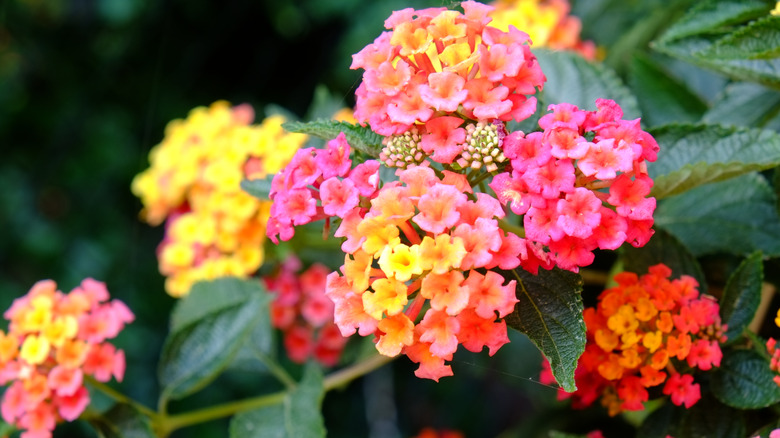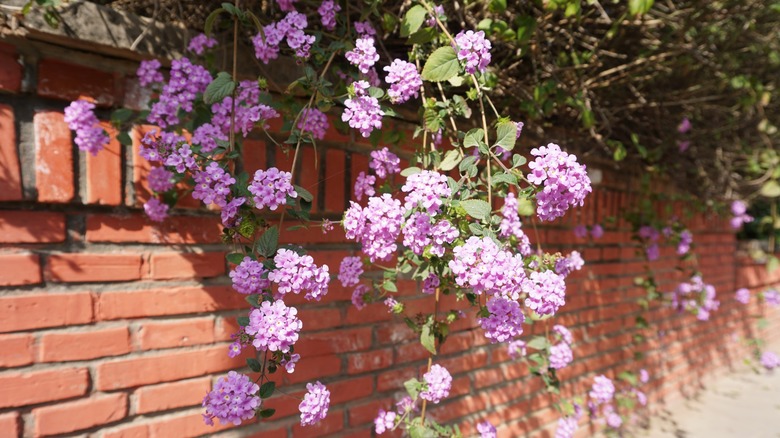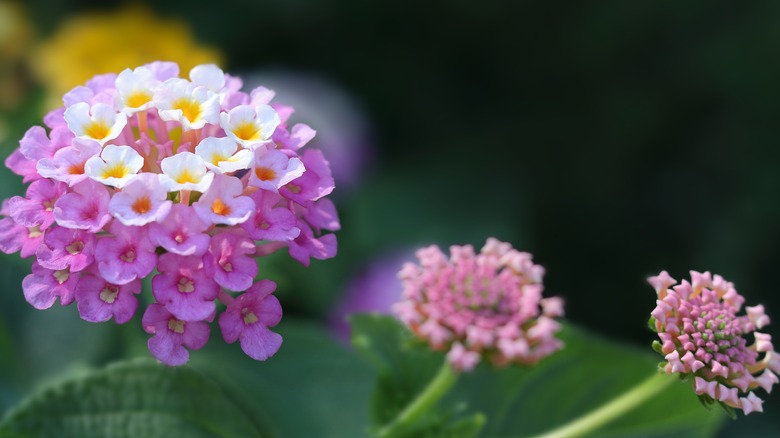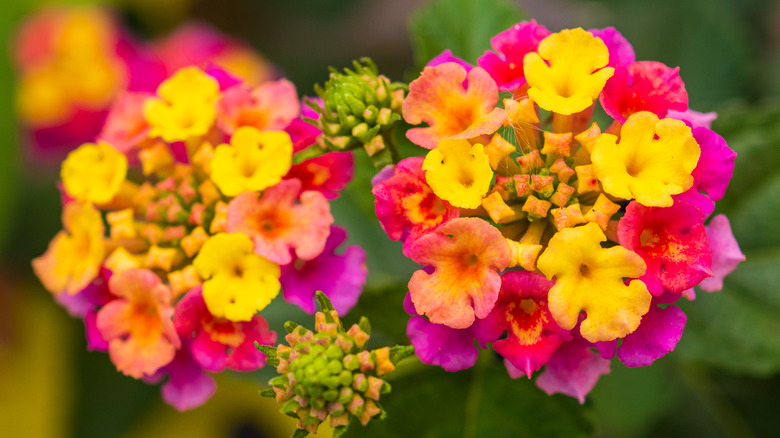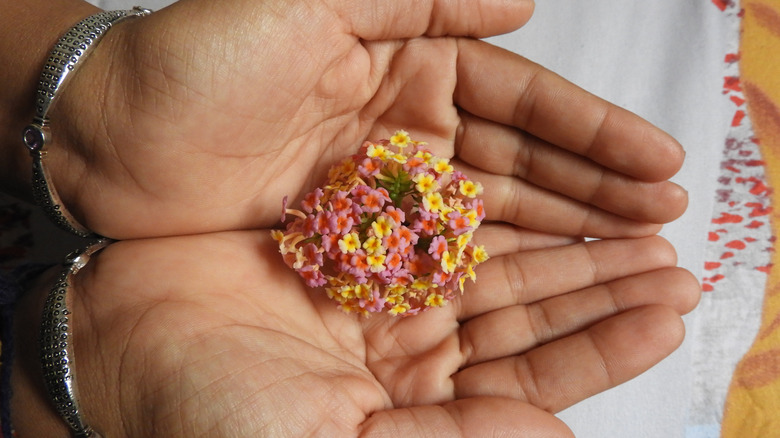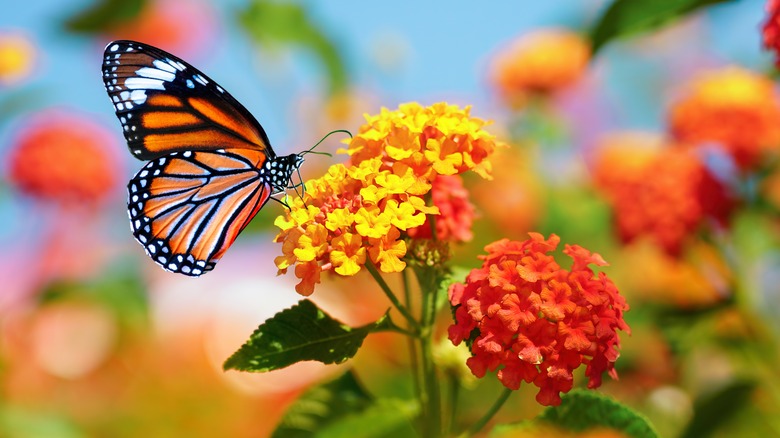How To Successfully Grow And Take Care Of Lantana Plants
Lyrically-named and flower profuse, lantana knows how to make an immediate impression. Colorful lantana is a fragrant, showstopping, neighbor-awing, landscape-boosting flowering plant that will brighten your beds and pots throughout the growing season.
Lantana is nature's crayon box of vibrant hues and pastel tints. Magenta and sunshine yellow. Lavender and white. Creamy ecru and buttercup. Pale pink and soft yellow. Coral and pumpkin. Red and gold. Tangerine and blushing rose. The combinations are nearly endless. Plant Care Today reports that the expansive selection is the result of hybridization, where plants are crossbred to create new varieties.
MasterClass explains that there are multiple varieties of lantana: Lantana camara (common lantana), Lantana horrida (Texas lantana), Lantana montevidensis (weeping lantana), and Lantana trifolia (popcorn lantana). Choosing which of the 150 varieties of the lantana genus to grow may be the most difficult part of cultivating lantana. Rooted in the ideal spot, it will reward you with an abundance of flowers with relatively little fuss or maintenance. With so many options, colors, and varieties, home gardeners can revel in the knowledge that there is a lantana to suit whatever gardening niche they have.
How to use lantana in garden
Versatility is a hallmark of lantana, a member of the Verbenaceae (verbena) family, so determining how to incorporate it into your garden plans is more about personal preferences than it is about the plant itself. It works well in a plethora of garden styles and domains, with sunshine being the common denominator.
Depending on the lantana you choose, Garden Design offers a range of choices on how the plant would work in a landscape plan. For example, they suggest including lantana in a butterfly garden with other flutter flyer favorites, as it, too, attracts the irresistible insects. The outlet also describes other planting opportunities, like having weeping lantana tumble over a wall, from a window box, or out of a hanging basket.
Eagleson Landscape Company explains that the profusion of flowers common to lantana makes it ideal for giving a garden a sultry flair. Even in colder climates where lantana is grown as an annual rather than a perennial, the plant has a way of evoking a tropical feel. It's a bonus that it comes in so many hues that one can match a lantana to the character of any yard.
How to grow lantana
Just like most humans, lantana loves a sunny day. These bloomers are partial to full sun, with six to eight hours of direct sunlight needed every day. Gardening Know How adds that it has a tolerance for a multitude of soil types, but it has a fondness for soil that leans acidic. They offer a simple way to ensure that the dirt is a bit acidic: mulch with a layer of pine needles.
When to plant lantana, particularly in those colder zones where it is an annual, is as much a concern as where to plant. According to Gardening Know How, gardeners will want to be sure the risk of frost has passed. The new plants like a steady sprinkle of water, says The Spruce, so regular dousing when lantana is first planted is important to keep it from drying out. But don't obsess over the lantana you're nurturing. You will want to find a comfortable balance between watering often and watering too infrequently. Also, check the temperature around your garden area because the flowers prefer 55 degrees or higher and don't have a problem with humidity.
How to care for lantana
This is one plant that exudes flower power, so says HGTV of the inexhaustible lantana. In addition, once planted, it's incredibly easy to maintain. Give it abundant sunlight (six hours or more) and regular watering, and you'll be rewarded with cheerful blossoms year-round in warmer climates and throughout the growing season in colder ones. Keep the blooms coming by removing the blossoms as they die. Deadheading keeps the plant looking healthy, according to The Herb Exchange, and encourages additional flowering. The flowers of a lantana can resemble tiny 1- or 2-inch bouquets; each bloom is actually many umbels, each of which looks like a tiny flower that form something like an umbrella shape.
Take note of the planting medium, however, adds HGTV. If the lantana is making its home in a container, soilless potting mixes allow better root development and water drainage. Proving that it isn't a very needy or demanding plant, lantana needs little fertilizing, says The Herb Exchange. It cautions that overdoing the fertilizer on the bloomers can do irreparable harm, ultimately killing your lantana. The Herb Exchange also cautions gardeners to watch for diseases and pests, noting that changes to the leaves can be an early warning sign of problems that can be traced to a host of issues from overwatering to powdery mildew. If you want to propagate your strong, healthy, beautiful lantana, The Herb Exchange recommends taking stem cuttings.
Varieties of lantana
With 150 species of lantana, as noted by Plant Snap, it's difficult to choose just a few to highlight. The beautiful flower is versatile and easy to grow, which enhances its popularity in gardens around the world, particularly in warm or tropical regions.
* Lantana camara (common lantana or shrub verbena) is common for a reason, per Proven Winners. It grows easily in a lot of climates, and it tends to make itself at home. Do some investigating to make sure it isn't an invasive species in your area. Two especially pretty versions are Bandana Cherry Sunrise with hot pink and orange umbels, and Luscious Pinkberry Blend with medium pink and pale-yellow umbels.
* Lantana montevidensis (weeping lantana) is a good species to seek out if you're looking for ground cover. This variety carpets the planting area with lavender blooms, says San Marcos Growers. The South American native, like other lantana, likes full sun, but can tolerate light shade and drought.
* Lantana horrida (Texas lantana) withstands just about any onslaught you throw at it (via the University of Texas). Drought? Who cares? Deer? Never heard of her. Road salt? Whatever! Texas lantana is one tough cookie.
* Popcorn Lantana (Lantana trifolia) makes a big statement, growing to a height of 5 feet in the warmest zones, sporting pink or purple blossoms (via Plant Care Today).
Is lantana toxic?
For as pretty as lantana is, there is a sinister side to the plant: It is toxic. Although there are some cultures that pick the ripe berries (and only the ripe ones) of lantana bushes and make jam and other food from them, the general consensus is that every part of a lantana is poisonous to humans and pets (via The Herb Exchange).
Plant Addicts cautions that care should be taken when handling lantana, even noting that the smoke resulting from burning lantana can cause be an irritant. They recommend wearing gloves to minimize contact, though they note that reactions to the plant can vary widely.
An article in Florida Today warns that lantana can be fatal to pets, including large ones like horses. Keeping animals away from lantana is important, says the North Carolina State Cooperative Extension office. They point out that the unpleasant symptoms can include labored breathing, vomiting, and diarrhea. In pets and livestock, reactions can be serious. Avoid planting it where they can easily get to it.
How to repot lantana
Lantana grown as an annual in colder zones generally will stay fairly small in size. When grown in more tropical locales, however, the bush can exceed 6 feet in height — necessitating managing your lantana bush by dividing it or transplanting it entirely.
If a lantana bush needs to be divided, the time to do that is in the spring, says Gardening Know How. They recommend locating a plant with a reduced number of flowers, particularly ones that seem to be dying in the center. Once chosen, the next step is to dig widely around the entire lantana plant, and pry up the crown of the plant with a shovel. With the roots exposed, a sharp knife will allow you to efficiently sever sections of the lantana. A successful division is most likely when each division contains a healthy stem and roots.
If the entire bush needs to be moved, Garden Guides says do it in spring or fall, and as is the case with most transplants, a cloudy day is likely to result in less stress to the plant. Gardening Know How describes each step in the process, including recommending that the lantana's new home be readied before digging up the one that needs to be transplanted. The lantana's roots may go as deep as a foot, and if it's a large bush, you may need to excavate a wide diameter. Once transplanted, deep watering will help the plant get used to its new spot.
Avoiding a lantana invasion
Not everyone loves lantana and its stunning mix of colors. In some parts of the United States, the beautiful flowering bush is considered to be an unwelcome visitor and is deemed to be invasive. Not all lantana varieties qualify for that moniker, but Lantana camara tops the list, and as a prevalent version of the plant (they don't call it common lantana for nothin'), it's important for growers to know what they're planting and how to manage it.
The Texas Invasive Species Institute offers detailed descriptions, including how to know if the species you're growing is the invasive type, and provides management solutions. If you have lantana and prefer not to pull the entire plant and discard it or use herbicides on it, they recommend controlling its growth by removing flowers before they ripen to seed. If you're aiming to avoid planting the invasive version of lantana and think you're safe by opting not to grow Lantana camara, we offer a word of caution: Lantana montevidensis can be invasive, too. Invasive types of lantana love wide open spaces and can quickly spread if not controlled.
Don't let the fear of a lantana invasion keep you up at night if you live in a colder climate. Dave's Garden points out that in areas that regularly receive temperatures below freezing, lantana is an annual. The loose seeds and errant sprouts are easily killed by the cold.
Hummingbirds and butterflies love lantana
Lantana puts on a riveting show for gardeners who want a lot of blossoms and an explosion of color. We humans aren't the only ones enjoying lantana, however; it's a favorite for hummingbirds, butterflies and other pollinators. Drawn to the plant for its strong scent and bright blooms, lantana is sure to attract attention. Birds & Blooms coos at the way butterflies gravitate toward lantana, noting excitedly that various swallowtail butterflies, along with monarchs, queens, and numerous others have a strong affinity for the flowers.
Hummingbirds find lantana appealing, says The Spruce, who place the bloomer among the top 19 of plants most likely to tease hummingbirds into your yard. Better Homes & Gardens concurs, noting that lantana also is drought- and deer-resistant. As you kick back to enjoy the potted lantana on your deck, glance around for the darting flight of hummingbirds and the silent flapping of a few butterflies.
